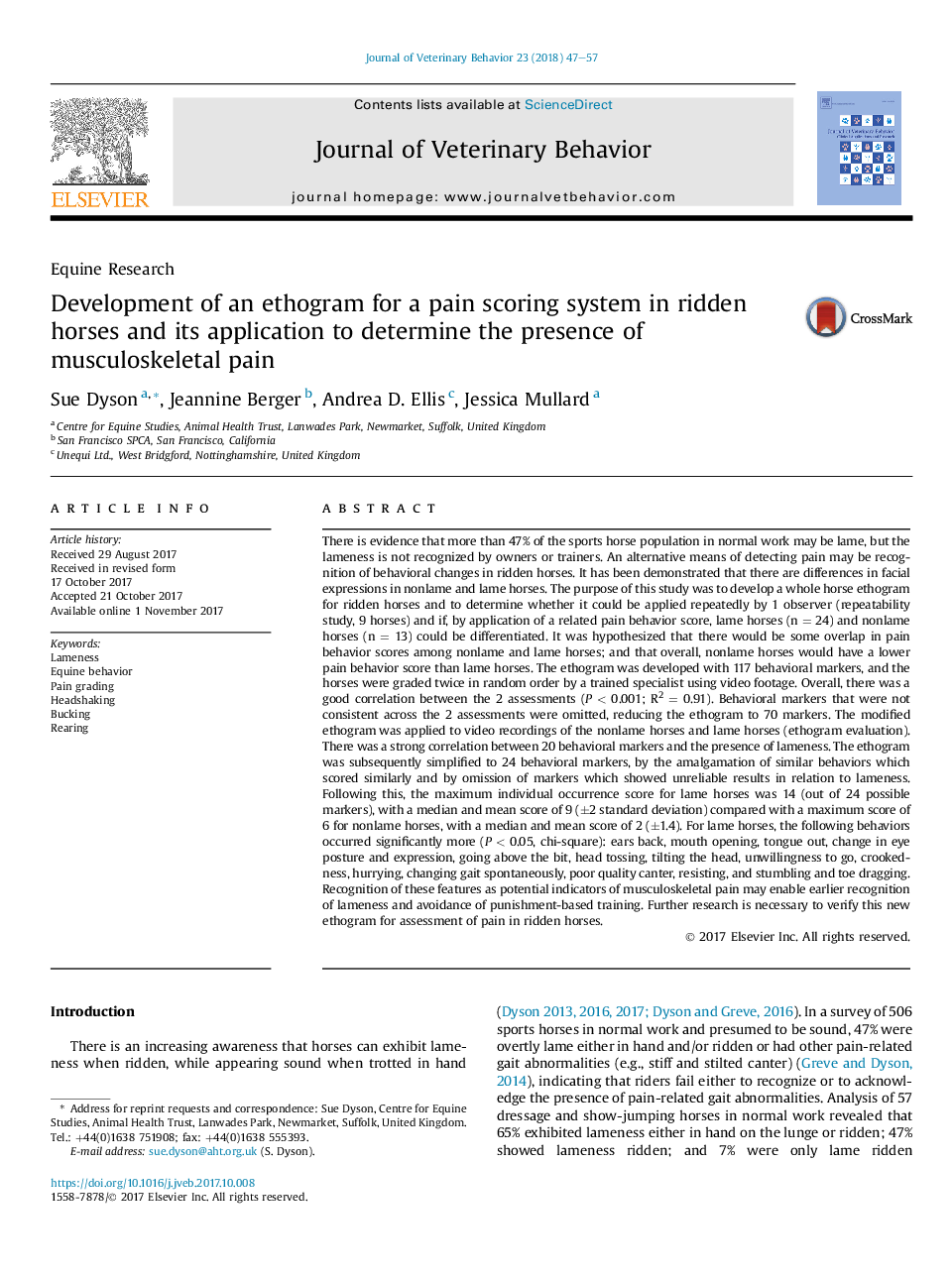| کد مقاله | کد نشریه | سال انتشار | مقاله انگلیسی | نسخه تمام متن |
|---|---|---|---|---|
| 8484202 | 1551593 | 2018 | 11 صفحه PDF | دانلود رایگان |
عنوان انگلیسی مقاله ISI
Development of an ethogram for a pain scoring system in ridden horses and its application to determine the presence of musculoskeletal pain
ترجمه فارسی عنوان
توسعه یک اختراع برای سیستم امتیازدهی درد در اسب سواری و کاربرد آن برای تعیین وجود درد اسکلتی عضلانی
دانلود مقاله + سفارش ترجمه
دانلود مقاله ISI انگلیسی
رایگان برای ایرانیان
موضوعات مرتبط
علوم زیستی و بیوفناوری
علوم کشاورزی و بیولوژیک
علوم دامی و جانورشناسی
چکیده انگلیسی
There is evidence that more than 47% of the sports horse population in normal work may be lame, but the lameness is not recognized by owners or trainers. An alternative means of detecting pain may be recognition of behavioral changes in ridden horses. It has been demonstrated that there are differences in facial expressions in nonlame and lame horses. The purpose of this study was to develop a whole horse ethogram for ridden horses and to determine whether it could be applied repeatedly by 1 observer (repeatability study, 9 horses) and if, by application of a related pain behavior score, lame horses (n = 24) and nonlame horses (n = 13) could be differentiated. It was hypothesized that there would be some overlap in pain behavior scores among nonlame and lame horses; and that overall, nonlame horses would have a lower pain behavior score than lame horses. The ethogram was developed with 117 behavioral markers, and the horses were graded twice in random order by a trained specialist using video footage. Overall, there was a good correlation between the 2 assessments (P < 0.001; R2 = 0.91). Behavioral markers that were not consistent across the 2 assessments were omitted, reducing the ethogram to 70 markers. The modified ethogram was applied to video recordings of the nonlame horses and lame horses (ethogram evaluation). There was a strong correlation between 20 behavioral markers and the presence of lameness. The ethogram was subsequently simplified to 24 behavioral markers, by the amalgamation of similar behaviors which scored similarly and by omission of markers which showed unreliable results in relation to lameness. Following this, the maximum individual occurrence score for lame horses was 14 (out of 24 possible markers), with a median and mean score of 9 (±2 standard deviation) compared with a maximum score of 6 for nonlame horses, with a median and mean score of 2 (±1.4). For lame horses, the following behaviors occurred significantly more (P < 0.05, chi-square): ears back, mouth opening, tongue out, change in eye posture and expression, going above the bit, head tossing, tilting the head, unwillingness to go, crookedness, hurrying, changing gait spontaneously, poor quality canter, resisting, and stumbling and toe dragging. Recognition of these features as potential indicators of musculoskeletal pain may enable earlier recognition of lameness and avoidance of punishment-based training. Further research is necessary to verify this new ethogram for assessment of pain in ridden horses.
ناشر
Database: Elsevier - ScienceDirect (ساینس دایرکت)
Journal: Journal of Veterinary Behavior - Volume 23, JanuaryâFebruary 2018, Pages 47-57
Journal: Journal of Veterinary Behavior - Volume 23, JanuaryâFebruary 2018, Pages 47-57
نویسندگان
Sue Dyson, Jeannine Berger, Andrea D. Ellis, Jessica Mullard,
